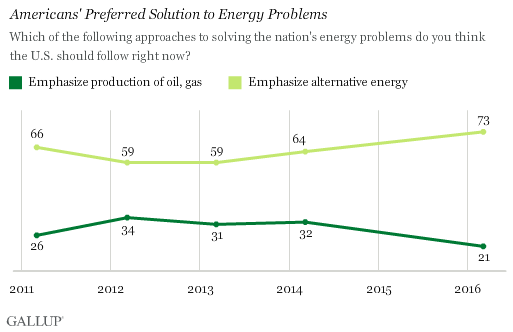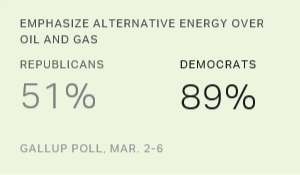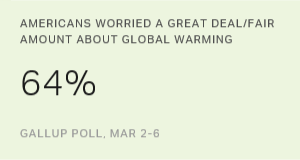Story Highlights
- 73% want U.S. to emphasize alternative energy rather than oil and gas
- Support increased among both Democrats and Republicans since 2013
- Higher support for alternative energy coincides with falling gas prices
WASHINGTON, D.C. -- Seventy-three percent of Americans say they prefer emphasizing alternative energy, rather than gas and oil production, as the solution to the nation's energy problems. This marks the highest percentage of Americans prioritizing alternative energy since Gallup first asked the question in 2011.

While a majority of Americans have preferred alternative energy solutions since 2011, support has increased substantially since 2013 (59%) and 2014 (64%).
These results are from Gallup's annual Environment poll, conducted March 2-6. From 2012 to 2014, the gap separating traditional and alternative energy advocates was stable, with differences between the two groups ranging from 25 to 32 percentage points. But this year, the gap has widened to 52 points.
Majority of Republicans Now Support Alternative Energy
While a majority of Democrats and Democratic-leaning independents have favored emphasizing alternative energy over traditional fossil fuel sources since 2011, this year marks the first time a majority of Republicans and Republican-leaning independents prefer an alternative energy strategy. The 51% of Republicans who now favor alternative energy is up from the previous high of 46% in 2011.
Both Democrats' and Republicans' support for an alternative energy strategy has grown steadily since 2013. Republicans' support grew eight points from 2014 to 2016, while Democrats' support increased five points over that same time period.

Support for Alternative Energy Coincides With Falling Fuel Prices
The increase in the share of Americans -- both Republican and Democrat -- preferring an alternative energy strategy in 2016 coincides with an oil supply surplus that has caused fuel prices to plummet. High fuel costs may prime American consumers to prefer increased production of oil and gas as a means to alleviate burdensome prices at the pump. Low fuel costs, however, might be paving the way for a greater willingness to support alternative energy solutions.
In the two years with the highest average gas price for the month preceding Gallup's survey ($3.64 in 2012 and $3.74 in 2013), alternative energy had its fewest advocates (59%). However, the spike in alternative energy proponents in 2016 corresponds with the lowest average fuel cost ($1.87) since Gallup first asked about energy solutions in 2011. If Americans view the price of gas as an indication that traditional fuel is in good supply, they may be more willing to sanction an emphasis on alternative sources because there is little risk of exhausting fossil fuel even with the shift in emphasis.
| Average Gas Price$ | Emphasize Alternative Energy% | ||||||||||||||||||||||||||||||||||||||||||||||||||||||||||||||||||||||||||||||||||||||||||||||||||
|---|---|---|---|---|---|---|---|---|---|---|---|---|---|---|---|---|---|---|---|---|---|---|---|---|---|---|---|---|---|---|---|---|---|---|---|---|---|---|---|---|---|---|---|---|---|---|---|---|---|---|---|---|---|---|---|---|---|---|---|---|---|---|---|---|---|---|---|---|---|---|---|---|---|---|---|---|---|---|---|---|---|---|---|---|---|---|---|---|---|---|---|---|---|---|---|---|---|---|---|
| March 2-6, 2016 | 1.87 | 73 | |||||||||||||||||||||||||||||||||||||||||||||||||||||||||||||||||||||||||||||||||||||||||||||||||
| March 6-9, 2014 | 3.43 | 64 | |||||||||||||||||||||||||||||||||||||||||||||||||||||||||||||||||||||||||||||||||||||||||||||||||
| March 7-10, 2013 | 3.74 | 59 | |||||||||||||||||||||||||||||||||||||||||||||||||||||||||||||||||||||||||||||||||||||||||||||||||
| March 8-11, 2012 | 3.64 | 59 | |||||||||||||||||||||||||||||||||||||||||||||||||||||||||||||||||||||||||||||||||||||||||||||||||
| March 3-6, 2011 | 3.26 | 66 | |||||||||||||||||||||||||||||||||||||||||||||||||||||||||||||||||||||||||||||||||||||||||||||||||
| Gas price data from U.S. Energy Information Administration. Average gas prices taken from month before poll. | |||||||||||||||||||||||||||||||||||||||||||||||||||||||||||||||||||||||||||||||||||||||||||||||||||
| Gallup Poll, March 2-6, 2016 | |||||||||||||||||||||||||||||||||||||||||||||||||||||||||||||||||||||||||||||||||||||||||||||||||||
Implications
In a time of notable partisan polarization, growing support for alternative energy among Republicans and Democrats represents a rare instance where a bipartisan coalition could form in support of an alternative energy strategy. Even though a substantial gap remains between Republicans and Democrats in emphasizing alternative sources, a majority of Republicans now support the idea. In fact, recent Gallup polls show Americans' concern about global warming is at an eight-year high, with both Democrats and Republicans stating a sharply higher concern for the issue in 2016.
Meanwhile, the perception that fuel is not in short supply -- as indicated by low gas prices -- may also contribute to more Americans now favoring alternative energy solutions. Absent an urgent desire to offset high fuel costs with increased fuel production, Americans may believe that greater investment in alternative energy strategies is a low-risk endeavor. As a result, if Americans perceive that the fuel supply is abundant, support for alternative energy could increase.
Last week, the Obama administration announced its plan to halt offshore oil and gas drilling set to take place in several southern U.S. states. Taken together, lower fuel prices and Americans' growing concern about global climate change could provide the groundwork for a policy shift toward alternative energy solutions.
Historical data are available in Gallup Analytics.
Survey Methods
Results for this Gallup poll are based on telephone interviews conducted March 2-6, 2016, with a random sample of 504 adults, aged 18 and older, living in all 50 U.S. states and the District of Columbia. For results based on the total sample of national adults, the margin of sampling error is ±6 percentage points at the 95% confidence level. All reported margins of sampling error include computed design effects for weighting.
Each sample of national adults includes a minimum quota of 60% cellphone respondents and 40% landline respondents, with additional minimum quotas by time zone within region. Landline and cellular telephone numbers are selected using random-digit-dial methods.
Learn more about how the Gallup Poll Social Series works.




